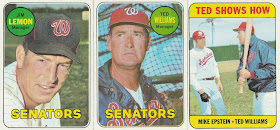Here is George Brunet’s 1969 card (using the same photo as his 1967 card). Brunet played for NINE teams during his major-league career, and switched teams so often that from the 1963 to 1970 sets, he only appeared wearing a cap in the 1968 set, and THAT one was airbrushed!
He did play for the California Angels from 1965-69, so there doesn’t seem to be any excuse why Topps couldn’t get a decent photo of him in an Angels’ cap from 1967 to 1969.
Brunet began his career in 1953 with the Shelby (NC) Clippers in the Tar Heel League. After 5 seasons
in the minors, he made his major-league debut with the Kansas City Athletics with a few games in September 1956. Brunet was back in the minors for most of ’57, all of ’58, and most of ’59.
George began the 1960 season with the Athletics, but by mid-May was traded to the Braves.
In May 1962, Brunet was traded to the Houston Colt .45s, 6 weeks into their inaugural season.
He must have felt like a yo-yo, because in July 1963 he was sold to the Orioles, who returned him to Houston the following May. Before he could get settled in back with the Colt .45s, he was sold to the Los Angeles Angels in August 1964.
I am surprised today to see that George pitched part of each season from 1960 to 1964 in the minors.
Brunet’s longest stint anywhere was with the Angels, from August 1964 to July 1969. It was also with the Angels that he managed to stay with the big club for the entire season, every season.
From 1965-68 George was a workhorse for the Angels, pitching in 41, 41, 40, and 39 games per season, most of them starts. The Angels were a bad team back then, so he did lead the AL with 19 losses in ’67 and 17 losses in ’68. Still, he remained in the lineup, so I have to think it wasn’t him.
Brunet began the 1969 season in the Angels’ rotation, but was sold to the expansion Pilots at the end of July. He never made it to Milwaukee the following season, as the team traded him to the Senators in December for pitcher
Dave Baldwin.
George split the 1970 season between Washington and Pittsburgh, then was traded to the Cardinals before the 1971 season (with outfielder
Matty Alou) for pitcher
Nelson Briles and outfielder
Vic Davalillo.
Brunet appeared in only 7 games for the Cards, and was released in early-May 1971.
He played the remainder of the 1971 season, and all of ’72 for the Padres’ AAA team in Hawaii. In 1973 he pitched for the Phillies’ AAA team.
While some American players go to Japan to extend their career, Brunet went to Mexico. He played in Mexico from 1974 to 1989, finally retiring at age 54, having pitched professionally for 36 years.
Brunet died in 1991 at age 56. In 1999 he was elected to the Mexican Baseball Hall of Fame.






